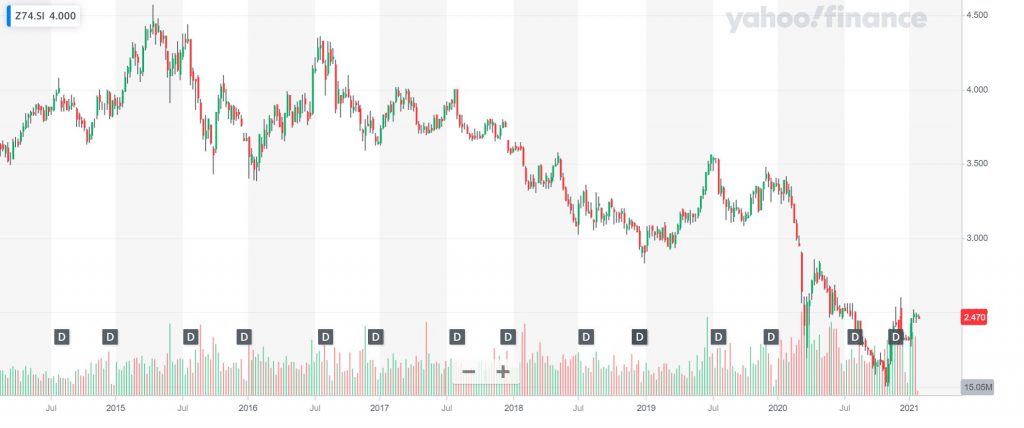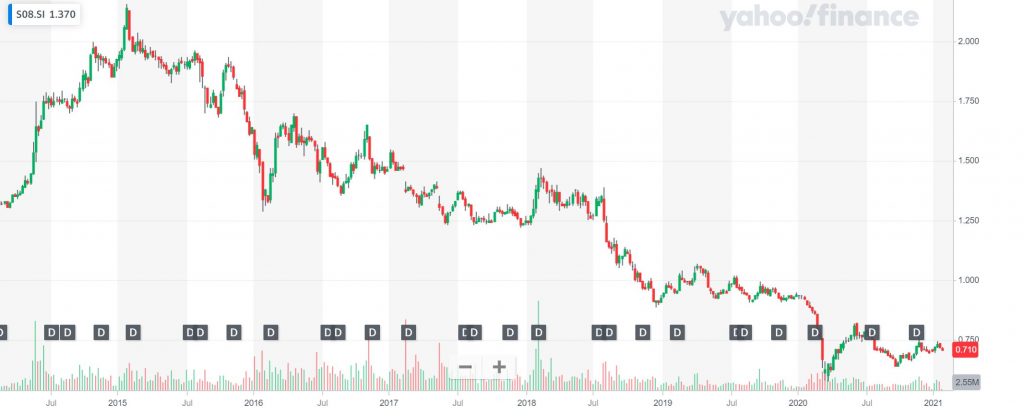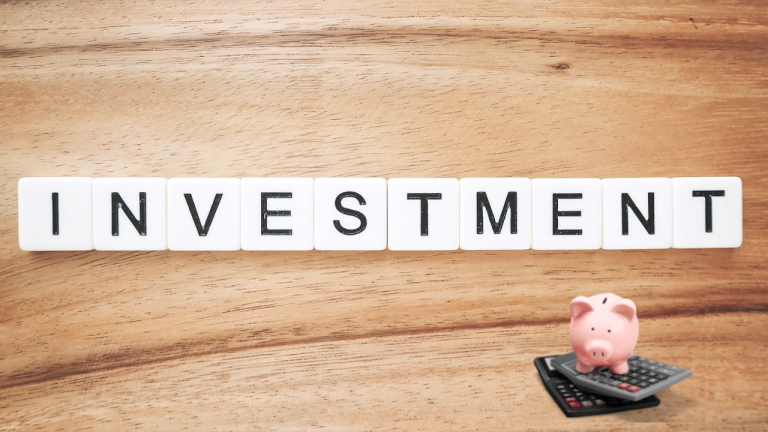Investing is a complicated process to tackle and it is of no surprise that rookie investors may stumble in the beginning. Making mistakes is part of the learning process, however, some of these mistakes can be costly when investing. Through this article, we will cover the 7 common mistakes that investors tend to make to help you avoid them and make better investing decisions.
1. Failure to set realistic investment goals and expectations
Many beginner investors start out with unrealistic expectations. They expect to earn very high returns within a short time frame or have totally zero risk tolerance. They expect that once they buy the stock, the market will only move in an upward direction. When they see that the stocks are not making money as what they are expecting, they panic and sell off the stocks immediately. This often results in making losses.
However, it is not impossible to make good gains within a short time frame. But more often than not, someone who invests in a consistent manner within a reasonable risk level profits better than those who invest a big sum of money inconsistently. Experienced traders who understand risk return ratio and technical analysis will have a slight edge in their trades. Therefore, by the law of large numbers, it is definitely possible to see an overall gain consistently.
When we talk about investing, there is certainly nothing speculative in nature in the very short term. While it is a bonus that we can do well in the short term, it is something we are less concerned about.
So how is this an issue?
Beginner investors often pin their expectations on the short-term returns and fail to realize that the stock market can be volatile. We always say that the stock market in the short term is a voting machine and in the long term, a weighing machine. Prices do not accurately reflect its worth when sentiments turn bearish. But if you were to buy the stock of a fundamentally good company, the stock price should rally up over time. Just be mindful that the stock price does not go up every single day. Therefore, every investor should set realistic expectations and know your risk tolerance. Set realistic goals on how long you expect to hold this investment and the expected returns. Know your risk tolerance and how much paper losses you can tolerate. If you are unable to tolerate high fluctuations in prices, should you then relook at the type of stocks that you are intending to invest in? A better approach could be to start with investing in ETFs as ETFs are generally less volatile as compared to individual stocks.
At the end of the day, make sure you have given due consideration to your investment goals, expectations and risk tolerance. This will prevent unnecessary losses as a consequence of panic-selling when the stock market doesn’t move in the way you expected it to be.
2. Making investment decisions based on emotions
This is easily the top mistake that many new investors make! Beginner investors make rash and irrational decisions by buying on greed when they see the stock prices increase or they experience FOMO (Fear Of Missing Out) and buy when they see their friends buying. Very often, they chase after the prices and end up buying at overly high prices. They may also panic-sell when they see prices falling and their peers selling off the positions. The investors fall into a situation of “buying high and selling low”, thus making losses. In fact, many retail investors – not just new investors, are still guilty of buying and selling stocks based on emotions.
Take for example the SPY ETF. If you had entered a position of SPY at US$140 just right before the prices declined by 50% in the 2008 recession, you would have profited by 140% by now, giving approximately 10% annualised return. Let’s look at a more recent example. If you already hold a position of SPY before the start of 2020 and were disciplined enough not to fall to the traps of panic-selling, you would still be up by nearly 10% return for 2020! Now, you can do the comparison yourself. What would it be like if you had instead sold off the position when the prices fell drastically during 2020? Thus, if you are disciplined enough not to let emotions overpower you to make impulsive choices, you will actually perform much better than many of the retail investors out there driven by emotions.
Ample homework and research should be done to identify the fundamentally good stocks and enter the market at a good price. Even if it is unfortunate that the stock prices fall the moment you entered the market, we should not fall to the traps of panic-selling as these prices are expected to go up in the longer term. Do not let your emotions overpower you and make rash decisions that you will regret later.
3. Investing based on news or analysts’ opinions
This brings us to the next point on doing research for our investments. We often hear people say “do your research before investing”.
But what kind of research are we supposed to do? What kind of information are we supposed to look out for?
Reading news media articles and following the news blindly is not what we consider as doing proper research. Performing proper research on the stock involves understanding the business of the company, the financial performance of the company as well as many other factors such as sustainability of the business. For example, if we are analysing the performance of REITS, we would do better by reading on the statistics of the trend for occupancy rates or the trend for the price per square feet rather than relying solely on news report articles or the opinions on the investing forums.
Many of you might be thinking – so are you saying that we should not read the news or the views of other investors?
Reading the news to keep yourself updated with the current affairs of the company is very useful. It is also always good to read up more on how other investors think and act. Gaining a new perspective will ensure you don’t neglect any critical factors you may have not noticed initially. Keeping an open mind on what you read and form your own opinion of certain topics and news articles instead of following blindly will allow you to make a much informed decision when investing.
Let me give you an example.
Fastly is a content delivery network company that transmits data to end users. It aims to deliver the best online experience through its edge cloud platform to move data closer and faster to end users.
In October 2020, Fastly’s stock price dropped by about 50%. If you have been reading the articles, you will see 2 differing views of whether it is the time to buy Fastly’s stocks or whether the drop still doesn’t make it a buy as the stocks are just too overvalued. So if you have not done the research on Fastly and you happen to see one of the articles standing for the proposition to buy Fastly’s stocks now, you may have already been convinced by that article to buy the stocks! But if you take a closer look at the financials of the company, you will realise that there are a few red flags such as a history of negative free cash flows, negative bottom lines and negative operating cash flows with 2020 being the first year that it turned positive.
Not to discredit fastly in any way, it is just not in my best interest to add it into my portfolio due to its negative track record. It does not meet the criteria for me to add into my portfolio based on fundamental analysis. While it may be a good buy in the future, this is mainly to minimise the risk of possible loss. Until I can see consistently good financial performance of the company, I will stay out of this stock.
So if that is the case, why do we still want to read these articles? This is because it would allow us to understand the general market sentiments which will drive the price movement. Say for example, there is some negative news for a particular company which you deemed as a fundamentally strong company. What we can do is to turn the negative news to our favour by buying more positions of this stock at a discount when the other retail investors do their panic-selling, pushing prices lower.
4. Lack of diversification
The next common mistake is lack of diversification. Simply put, do not put all your eggs in one basket. Some new investors are inclined to throw all their money into that 1 stock which they heard about from their friends, hoping that this 1 stock will earn them some good returns. As a general guide for beginners, it would be good to hold around 4 or 5 stocks to diversify your risks depending on the size of your portfolio. By diversification, you can do so either by industry or geographically. You can choose to diversify by industry sectors such as buying stocks from both the technology and healthcare industry or to diversify by geography such as the US market or the China market.
Diversification, however, is not throwing your money into different baskets just for the sake of doing it. We still have to screen for fundamentally strong stocks and diversify by buying only the fundamentally strong stocks. We’ve got to ensure that our eggs are placed only in the sturdiest baskets. If you diversify by adding into your portfolio both good and bad stocks, you will likely just end up at status quo or even risk being in a worse off state as the losses will offset the profits.
If researching for a basket of stocks sounds a little tedious, a simple way to diversify your portfolio among different sectors is to purchase the SPY ETF which is a basket of securities that tracks the Standard & Poor’s 500 Index. By investing in SPY ETF, you are as good as investing in all the companies that the ETF tracks, thus reducing the concentration risk on any particular company.
Do obtain an understanding of what are the underlying companies of the ETFs you bought. This is to avoid over-allocating your portfolio to certain companies unless they are known to be good businesses. Nevertheless, you are still exposed to country-specific risks by purchasing the SPY ETF alone. You may also reduce your reliance on US equities by also being weighted on the China or Singapore market as well.
5. Blindly buying at the bottom
“Buy low, sell high!” This is the catchphrase of many investors. But we must understand that not all stocks will rally up. Fundamentally strong companies will have their stock prices go up in the long run, while the weaker companies may take much longer or never recover at all. New investors may fall trap to the attractively low prices for these stocks, not knowing that there is a high chance the stock prices will not go up. Let’s take a look at the stock price charts of some companies you may be familiar with.

Extracted from: Yahoo Finance
When you see this stock chart, what is your first impression? You might be thinking that this must be some Singapore company that you have never heard about. And actually, this is the stock price chart of Singtel, the top telecommunication company in Singapore! Singtel’s stocks have been on a downtrend since 2015.
If you have started out on investing back in 2015, you may probably be enticed by the declining prices, thinking that you can enter some positions at a low price so that you can close off these positions in the future at a higher price. Because that’s what we always think right? To buy low and sell high. Coupled with the ingrained impression that Singtel must be a very safe stock to buy because it is the top telco company in Singapore backed by Temasek Holdings which has substantial shareholding in Singtel. But after holding the stocks for 5 years, you will find yourself in disappointment that the stock price dropped by 50%.
Recently, it was announced that Singtel was awarded the licence to operate as a digital bank together with Grab. But if you ask me, I think there is still insufficient information or statistics about how the digital bank licence will help Singtel to turnaround in order for me to be enticed to buy the stocks now.

Extracted from: Yahoo Finance
This example might surprise you yet again because this is the stock chart prices of Singapore Post. SingPost’s stock prices fell by more than 50% since 2015. Yet, we still hear people around us talking about investing in Singtel and SingPost shares despite the clear downtrend.
All these examples show us that it doesn’t mean that we must always catch the opportunity and buy when stock prices drop. In fact, we should always first analyse the financials of the company and other important factors to determine if the business is a good one to invest in. Take a look at the financial performance of Singtel and SingPost. We do not see consistently increasing revenue, gross profit or net profit. And these are just only a few of the many indicators we look out for. Clearly, it would make more sense to focus our attention and efforts on other stocks that are a better buy.
Charts don’t lie.
6. Failure to realise that the market is forward looking
Many people do not realize that the stock market is not the economy. In fact, the stock market is forward looking and always leads the economy.
Why is this so?
According to Investopedia, “the stock market refers to the collection of markets and exchanges where regular activities of buying, selling, and issuance of shares of publicly-held companies take place.”
Now ask yourself, who are the ones involved in the buying and selling of shares? It’s the investors. As shared in the earlier points, retail investors are driven by emotions and sentiments. These sentiments include what the investors think about the future of the companies traded on the exchange. So if the investors are optimistic about the future performance of a company, they will think that the stock will be worth more in the future and hence, are willing to pay more now to buy the shares, driving the prices up. Therefore the stock market always moves faster than the economy.
Let us look at the stock market prices during this COVID-19 pandemic. In March 2020, the stock market fell to the bottom. At that time, the economy was still not at its lowest point. When the economy dipped to its lowest, with worldwide news of high unemployment rates, the stock market was already on its way to recovery, with some stocks already recovering to their pre-covid levels.
But many investors do not recognise this fact. They do not understand that economic data is old news to the stock market! They tend to follow the reported news about the economy and the recession. As a result, when the market dipped to its lowest in March 2020, they did not ride on the opportunity to buy more positions of the good stocks. Instead, they followed the unemployment and recession news and only started to buy more positions when the stock market had already recovered to pre-covid levels. Such a mistake cost them to miss out on the huge rally that came after. As an investor, we should always remember that the market is forward looking in order not to miss out on big opportunities! If we wait until all the rosy news is out, we will be late to the party already.
7. Abandoning or forgetting about your portfolio
Many new investors are so hyped up and excited about buying their first stock. They take it to their social media profiles, posting about their first buy and their path to adulthood. Or they flaunt to their friends that they are on their way to big money. They do things to celebrate their first buy but they forget about their portfolio after a few months. They forget to review their portfolio regularly and they have no idea how much paper gains or losses they are making. I must caution you that this should not be the way unless your portfolio is made up of just ETFs that have a long term history of performing well in the long run. Otherwise, you may miss out on potential selling opportunities or risk growing your paper losses.
Companies may not always be doing as well as they used to be and the fundamentals of a company may deteriorate overtime. When it comes to stocks investing, it should never be a set and forget approach. If the investment thesis for a certain stock no longer holds, you may want to consider offloading it to better deploy your funds elsewhere. Many investors lose huge amounts of money, not just because they bought the wrong stock, but because they bought the wrong ones and held on for a long period of time.
On the other hand no matter how good a stock is, there will always be periods when its price is in consolidation or when hit with temporary bad news, re-traces significantly. There is nothing wrong as an investor, to sometimes trim your profits and take them off the table, especially when the price has over extended or is severely overbought. This is especially profitable if you are someone who knows about technical analysis.
I used to be a long term investor in my earlier days but as I got better with technical analysis, I was able to identify major turning points in the market and make more than what I would have by being just a long term investor. But you can simply just be a long term investor and still make good gains as long as you buy the right thing. When you hold the right stocks you may only need to check on your portfolio once a week or fortnight during normal market conditions.
As you can see, whether or not the stocks perform very well or badly, reviewing your portfolio from time to time will ensure good housekeeping and allow it to grow healthily.
Making a mistake is normal and common, however, if you stick to our advice and beware of these rookie mistakes, you would be able to perform better than many of the new investors. Investing will never come without risks, hence being wary and alert will prove itself useful to you when achieving your financial goals.



